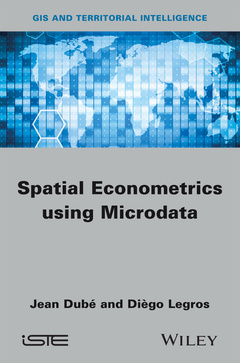Description
Spatial Econometrics using Microdata
Authors: Dubé Jean, Legros Diègo
Language: English
Subject for Spatial Econometrics using Microdata:
250 p. · 16.4x24.3 cm · Hardback
Description
/li>Contents
/li>Biography
/li>
This book provides an introduction to spatial analyses concerning disaggregated (or micro) spatial data.
Particular emphasis is put on spatial data compilation and the structuring of the connections between the observations. Descriptive analysis methods of spatial data are presented in order to identify and measure the spatial, global and local dependency.
The authors then focus on autoregressive spatial models, to control the problem of spatial dependency between the residues of a basic linear statistical model, thereby contravening one of the basic hypotheses of the ordinary least squares approach.
This book is a popularized reference for students looking to work with spatialized data, but who do not have the advanced statistical theoretical basics.
ACKNOWLEDGMENTS ix
PREFACE xi
CHAPTER 1. ECONOMETRICS AND SPATIAL DIMENSIONS 1
1.1. Introduction 1
1.2. The types of data 6
1.2.1. Cross-sectional data 7
1.2.2. Time series 8
1.2.3. Spatio-temporal data 9
1.3. Spatial econometrics 11
1.3.1. A picture is worth a thousand words 13
1.3.2. The structure of the databases of spatial microdata 15
1.4. History of spatial econometrics 16
1.5. Conclusion 21
CHAPTER 2. STRUCTURING SPATIAL RELATIONS 29
2.1. Introduction 29
2.2. The spatial representation of data 30
2.3. The distance matrix 34
2.4. Spatial weights matrices 37
2.4.1. Connectivity relations 40
2.4.2. Relations of inverse distance 42
2.4.3. Relations based on the inverse (or negative) exponential 45
2.4.4. Relations based on Gaussian transformation 47
2.4.5. The other spatial relation 47
2.4.6. One choice in particular? 48
2.4.7. To start 49
2.5. Standardization of the spatial weights matrix 50
2.6. Some examples 51
2.7. Advantages/disadvantages of micro-data 55
2.8. Conclusion 56
CHAPTER 3. SPATIAL AUTOCORRELATION 59
3.1. Introduction 59
3.2. Statistics of global spatial autocorrelation 65
3.2.1. Moran’s I statistic 68
3.2.2. Another way of testing significance 72
3.2.3. Advantages of Moran’s I statistic in modeling 74
3.2.4. Moran’s I for determining the optimal form of W 75
3.3. Local spatial autocorrelation 77
3.3.1. The LISA indices 79
3.4. Some numerical examples of the detection tests 86
3.5. Conclusion 89
CHAPTER 4. SPATIAL ECONOMETRIC MODELS 93
4.1. Introduction 93
4.2. Linear regression models 95
4.2.1. The different multiple linear regression model types 99
4.3. Link between spatial and temporal models 102
4.3.1. Temporal autoregressive models 103
4.3.2. Spatial autoregressive models 110
4.4. Spatial autocorrelation sources 115
4.4.1. Spatial externalities 117
4.4.2. Spillover effect 119
4.4.3. Omission of variables or spatial heterogeneity 123
4.4.4. Mixed effects 127
4.5. Statistical tests 129
4.5.1. LM tests in spatial econometrics 134
4.6. Conclusion 140
CHAPTER 5. SPATIO-TEMPORAL MODELING 145
5.1. Introduction 145
5.2. The impact of the two dimensions on the structure of the links: structuring of spatio-temporal links 148
5.3. Spatial representation of spatio-temporal data 150
5.4. Graphic representation of the spatial data generating processes pooled over time 154
5.5. Impacts on the shape of the weights matrix 159
5.6. The structuring of temporal links: a temporal weights matrix 162
5.7. Creation of spatio-temporal weights matrices 167
5.8. Applications of autocorrelation tests and of autoregressive models 170
5.9. Some spatio-temporal applications 172
5.10. Conclusion 173
CONCLUSION 177
GLOSSARY 185
APPENDIX 189
BIBLIOGRAPHY 215
INDEX 227
Jean DUBÉ is Professor in regional development at Laval University, Canada.
Diègo LEGROS is a lecturer in economics and management at the University of Burgundy, France.

